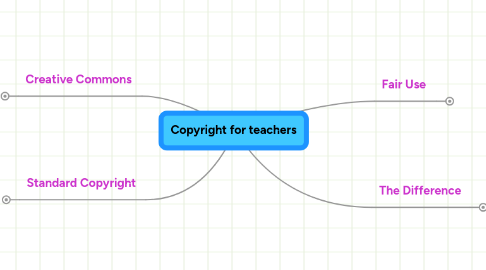Copyright for teachers
von Hannah Decker


1. Creative Commons
1.1. Creative Commons (CC) creates a balance between "all rights reserved" and no restrictions at all. CC is a set of copyright licenses and tools that one can chose from. It allows the original creator to keep their copyright while allowing certain uses of their work. CC is a "some rights reserved" policy. It allows for creativity and sharing while still protecting the original creator's rights.
1.2. http://creativecommons.org/
2. Standard Copyright
2.1. When something is created all of the rights to that work are for the original creator. Others are not allowed to use any part of the work without the creator's permission. The owner also has the right to seek compensation if they believe their material has been wrongfully used.
2.2. The creator of the work has the exclusive right to reproduce, distribute, copy, display, or change the work in any way.
2.3. Standard Copyright covers seven different categories. These include literary works, musical works, dramatic works, choreographed works, pictures graphics, or sculptures, motion pictures, and sound recordings.
3. Fair Use
3.1. Fair Use is an exception to the Copyright Act allowed by the original creator. It allows people other than the copyright owner to copy part or all of the work.
3.2. It is important that teachers understand what Fair Use permits them to use and do. Fair Use helps teachers figure out what kind of work they can use and share in their classroom. But it still allows them to bring their own creativity to the lesson. For example a teacher might want to include pictures in her lesson to expand students understand of the topic.
3.3. There are four factors which are balanced to measure Fair Use on a case-by-case base.
3.3.1. 1) The Transformative Factor: The purpose and character of use. Is the new work the same or different? Will you make money from it or not?
3.3.2. 2) The nature of the copyrighted work: There is more leeway when using works for informational benefits rather than from fictional works.
3.3.3. 3) The amount or portion of the work taken: The less information taken, and the less important the portion is to the piece the more likely you are to be excused from copyright laws.
3.3.4. 4) The effect of the use upon the potential market: The use of the material should not enfringe on the owners rights.
3.4. It is important that teachers stay up to date with any changes that may be made to Copyright and Fair Use laws. Teachers and schools should frequently watch and check for any changes. By collaborating as a school teachers can unsure that everyone is aware of current laws regarding Copyright and Fair Use laws.
3.4.1. Some resources to stay informed
3.4.1.1. http://www.copyright.gov
3.4.1.2. http://fairuse.stanford.edu/
